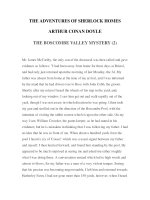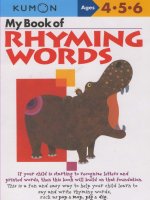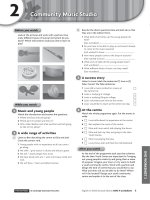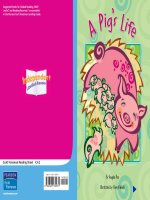4 2 st augustine our first city
Bạn đang xem bản rút gọn của tài liệu. Xem và tải ngay bản đầy đủ của tài liệu tại đây (3.63 MB, 10 trang )
ST. AUGUSTINE
OUR FIRST CITY
Fascinating Facts
• The real name of the pirate Blackbeard, who
attacked Spanish ships along the Florida coast,
was Edward Teach (or Thatch).
• Juan Alonso Cabale, whose ancestors were
Spanish settlers and Timucua Indians, was
the last person who could speak the Timucua
language. He died in 1767.
• Even though St. Augustine was a colony founded
by Spanish settlers in 1565, no king or queen of
Spain visited it until April 1, 2001—almost 436
years later!
Genre
Nonfiction
Comprehension Skill
Compare and
Contrast
Text Features
• Maps
• Time Line
• Captions
Scott Foresman Social Studies
ISBN 0-328-14874-1
ì<(sk$m)=beihef< +^-Ä-U-Ä-U
BY ELLEN CUTLER
Write to It!
St. Augustine, Florida, was built by the Spanish
on the site of a Native American village and is
the oldest European settlement in America. In
this book you will read about the history of St.
Augustine and what life was like when Florida
was still part of the Spanish Empire.
ST.AUGUSTINE
Both the Spanish culture of the colonists and
the culture of the Native Americans affected
each other. How has the culture in your
community changed over the years? What has
caused some of these changes? Interview
parents, family members, and older citizens
to find out their point of view. Write a threeparagraph magazine article summarizing your
interviews.
OUR FIRST CITY
Vocabulary
expedition
colony
empire
Write your article on a separate sheet of paper.
thatch
culture
descendant
criollo
missionaries
convert
mission
Maps
BY ELLEN CUTLER
2, 3, 14 MapQuest, Inc.
Photographs
Every effort has been made to secure permission and provide appropriate credit for photographic material. The publisher deeply
regrets any omission and pledges to correct errors called to its attention in subsequent editions.
Unless otherwise acknowledged, all photographs are the property of Scott Foresman, a division of Pearson Education.
Photo locators denoted as follows: Top (T), Center (C), Bottom (B), Left (L), Right (R) Background (Bkgd)
ISBN: 0-328-14874-1
Copyright © Pearson Education, Inc. All Rights Reserved. Printed in the
United States of America. This publication or parts thereof may be used with appropriate
equipment to reproduce copies for classroom use only.
1 2 3 4 5 6 7 8 9 10 V0G1 14 13 12 11 10 09 08 07 06 05
Opener: (C) ©Wolfgang Kaehler/Corbis
2 (Bkgd) Getty Images
4 The Granger Collection Editorial Offices: Glenview, Illinois • Parsippany, New Jersey • New York, New York
8 Nik Wheeler/Corbis
9 Private Collection/Bridgeman
Library International
SalesArtOffices:
Needham, Ltd.
Massachusetts • Duluth, Georgia • Glenview, Illinois
10 Library of Congress, Washington
D.C., USA/Bridgeman
Art Library • Mesa, Arizona
Coppell, Texas
• Ontario, California
11 The Granger Collection
12 Richard Cummins/Corbis
ALABAMA
GEORGIA
A Brief History of Florida
ATLANTIC
OCEAN
St. Augustine, Florida, is the oldest European
settlement in what is now the United States of
America. In 1565 St. Augustine was a Native
American village that had become home to a few
Spanish soldiers and settlers. Today it is a pleasant
town whose beaches, golf courses, and historic sites
attract many visitors.
The history of St. Augustine is part of the larger
history of European settlers in America.
Pensacola
San Luis
N
San Mateo
Castillo de
San Marcos
St. Augustine
Cape
Canaveral
Gulf of Mexico
Tampa Bay
Lake
Okeechobee
Charlotte Harbor
0
0
75
75
150 Miles
Biscayne
Bay
150 Kilometers
EUROPE
N
SPAIN
NORTH
AMERICA
Palos
Canary
Islands
Bahama
Islands
Cuba
AFRICA
San Salvador
Island
ATLANTIC OCEAN
Key
Hispaniola
Caribbean Sea
0
0
500
500
1,000 Miles
1,000 Kilometers
SOUTH AMERICA
2
Columbus’s
first voyage,
1492–1493
In 1492 Christopher Columbus set out from
Spain across the Atlantic Ocean. He believed that
the fastest, easiest way to get to China and India in
the Far East was to sail due west. When Columbus
landed in the islands southeast of Florida, he
claimed them for the king and queen of Spain.
Spanish explorers who followed Columbus sailed
farther and found a huge land beyond the islands
where Columbus first landed. They claimed these
lands for Spain too.
3
Juan Ponce de León was one of these Spanish
explorers. He was also the person who gave Florida
its name.
In 1513 Ponce de León led an expedition up the
Atlantic coast of North America, sailing past tiny
islands and beautiful beaches. He brought his men
ashore at a place near present-day St. Augustine
that was filled with sweet-smelling flowers. It was
springtime, near the time of Spain’s Pascua florida
(PAHS-koo-a FLOOR-ee-dah) or “flowery Easter,”
so he named the land “la Florida.”
In 1521 Ponce de León returned to Florida with
the intention of founding a colony. His efforts
failed, and he was
badly wounded in
an attack by Native
Americans. Over
the next forty years,
others would try to
colonize Florida, but
they also would fail.
Is There Really a Fountain of Youth?
Ponce de León discovered Florida while
searching for the island of Bimini. He had
heard about a spring there with waters that
would make a person young forever. Bimini not
only had this “Fountain of Youth,” but it was
supposed to be full of gold and other treasures.
Did Ponce de León believe in the “Fountain
of Youth”? It is hard to tell. Legends about
a magical spring had existed for more than
a thousand years. The promise of gold was
probably more important to him. Ponce de León
must have thought he would find something
because he paid for everything himself—three
ships, sailors, food, and equipment.
The area that Ponce de León named “la Florida”
was much larger than the state of Florida is today. It
stretched westward across Alabama and Louisiana
to the Mississippi River. It also went up the Atlantic
coast as far north as the Virginia border.
Juan Ponce de León
4
5
The Founding of St. Augustine
Spain was not the only empire in Europe that
was interested in America. In 1564 France built a
colony named Fort Caroline and claimed Florida
for itself. The king of Spain sent Pedro Menéndez
de Avilés to drive the French out and replace their
colony with a Spanish one.
In 1565 Menéndez and his troops set up a base
in a Timucua Indian village near Fort Caroline. He
destroyed the French colony and put Florida back
under Spanish control. He named the Timucua village
St. Augustine and brought colonists to live there.
Most of the people in St. Augustine were men.
Only twenty-six people were women and some of
the people were enslaved Africans.
At first the Timucua were friendly. They gave
the colonists food and showed them how to build
thatch houses. When problems arose, the colonists
moved to an island across the bay where they
would feel safer. Only the soldiers stayed behind.
The townspeople came back to St. Augustine
in 1572, but life in this colony was still hard. St.
Augustine was destroyed by fire several times and
suffered through many storms. Some of the worst
hurricanes came in 1599, 1638, 1674, and 1707.
Important Dates in the History of
Florida and St. Augustine
1492
Christopher
Columbus arrives in
islands near Florida.
1513
1845
1565
1740
Menéndez founds
St. Augustine
and destroys the
French colony.
British settlers
in the colony of
Georgia attack
St. Augustine.
Florida becomes
the 27th state in
the United States of
America.
1783
Spain takes
back control of
Florida after the
American War for
Independence.
Ponce de León
claims new land for
Spain and names it
“la Florida.”
1490
1530
1570
1610
1650
1690
1730
1770
1810
1577
1564
Missionaries arrive in
large numbers in Florida to
convert Native Americans to
Christianity.
France founds a colony on
the northeastern coast of
Florida.
6
1850
1763
1821
Spain loses Florida
to Great Britain.
Spain gives
Florida to the
United States.
7
The Castillo de San Marcos
The Castillo de San Marcos (Cass-TEE-yo
day san Mar-cohs) was the first fort built from
stone in the United States. The stone came
from a nearby island and is called coquina
(coh-KEE-nah), which means “little shells,”
because it is full of tiny bits of seashells. The
building of the fort was begun in 1672 and
took twenty-three years to complete.
A Timucua village
The Timucua Indians
The Timucua Indians lived throughout northern
Florida for more than a thousand years before
the Spanish explorers arrived. They lived in palm
thatch huts. Important meetings took place in the
council house in the center of the village. The whole
community cooked and ate together, and extra food
was stored in a central spot.
Both men and women held important positions in
the village. The role of chief was handed down from
fathers to sons. If there were no sons, however, a
woman could become chief. Much of what we know
about the Timucua comes from the first Europeans
to see them. Most of the writings describe Timucua
men and their activities and pay little attention to
the lives led by women.
8
9
Timucua men knotted their long hair on top of
their heads and tattooed their bodies. They hunted
game—bears, deer, wild turkey, and alligators—
with spears, clubs, and bows and arrows. The meat
from these animals was smoked over an open fire.
They also made dugout canoes from the trunks of
large trees.
The women planted corn, beans, and squash
in small cleared areas. They also gathered roots,
berries, and nuts that grew wild in the forests. They
did all the cooking and sewed clothes from animal
skins. They also made cooking pots from clay they
dug from the ground. Other Timucua craftspeople
made objects out of bone, shell, stone, and wood.
10
This is one of the first drawings of Native
Americans made by a European.
In 1565 the Timucua chief of the area around
St. Augustine was named Seloy. He seemed to be
friendly toward the Spanish, at least for a while.
He invited Menéndez and his troops to stay in his
village and even welcomed the settlers who then
arrived. Soon, however, Seloy and his people found
it necessary to protect their land. They attacked the
Spanish fort, setting it on fire with burning arrows.
The arrival of Europeans in Florida introduced
diseases that killed many of the Timucua. The
Spanish also depended on the Timucua for labor,
making them work in the fields and cut and carry
stone and trees for new buildings. Less than two
hundred years after the founding of St. Augustine,
the Timucua people had disappeared.
11
St. Augustine was far from Spain but shared the
same culture: laws, customs, and even building
styles came from Spain.
The most important people in St. Augustine also
had strong ties to Spain.
Colonists born on the Spanish peninsula were
known as peninsulars (peh-NIN-seh-lehrs).
Peninsulars held the best jobs and had the most
money and power. Their descendants born in
America were called criollos (cree-OH-yohs).
Criollos were of pure Spanish blood. None of their
parents or grandparents were Native Americans
or Africans. The peninsulars and criollos of St.
Augustine clung to the culture of Old Spain.
Life in Spanish St. Augustine
St. Augustine was a poor town. It had no
goldmines or forests and little land for farming.
It was also a small town, far away from
important Spanish colonies in Cuba and Mexico.
St. Augustine, however, had been built at a useful
location on the seacoast. Ships on their way back
to Spain and loaded with treasure could hide in
the harbor from pirates. Soldiers in the fort kept
Florida safe.
12
13
Many peninsulars and criollos were poor. In
the early years of the colony, most soldiers were
peninsulars and a few were criollos. Even the
poorest among them were better off than Native
Americans or free blacks. African enslaved people
had the worst life of all.
While the culture of the rich and powerful
remained Spanish, things were different among the
poor. For many years, there were more men than
women in colonies like St. Augustine. Poorer men—
especially soldiers—often married Native American
women. These blended families soon created a
unique culture that combined Spanish, Native
American, and African traditions.
San
Carlos
ATLANTIC
OCEAN
GEORGIA
Santa
Maria
EE
San
San Lorenzo
Damian APALACHEE de Ibitachuco
San Mateo
San Luis
Santa Elena
San Pedro
de los Chines
San
Miguél
UC
UA
Santa Catalina
de Guale
St. Johns Bay
TI
M
M
UC
UA
San Juan Guarcára
San Juan del Puerto
TI
AP
AL
AC
H
San
Nicolás
San
Pedro
Santa Catalina
Santa Cruz de Tarihica
Apalachee
Santa
Santa
Cruz
de
Ajohica
Bay
Rosa
Santa Fé de Toloca
TI
MU
San Francisco
CU
A
de Potano
Gulf of Mexico
Nombre
de Dios
St. Augustine
San Diego
San Antonio
de Anacape
Tissimi
San Luis de Acuera
Santa Lucia de Acuera
Key
Mission
Spanish missionaries came to Florida in
large numbers to convert Native Americans to
Christianity. Spain saw this as another way to keep
the colonies under its control.
Missionaries built missions, religious
communities that provided housing, care, and
education. They gave Native Americans new names,
a new language, and taught them Spanish customs.
The first mission was founded just outside of St.
Augustine. By 1675 a chain of missions reached
across northern Florida.
As Native Americans grew fewer in number, most
of the missions disappeared. Attacks by settlers in
the English colonies of Georgia and Virginia also
led to the end of the missions.
In 1764 Florida became part of the British
Empire, and St. Augustine became an English
town. The United States took possession of Florida
in 1821, and in 1845 Florida became the twentyseventh state of the Union.
San Salvador
de Mayaca
San Luis
de Eloquale
Mission trail
Nuestra Señora de
Guadalupe de
Tolomato
St. Augustine and the
Spanish Missions
Autocuimi
N
APALACHEE
Native American group
TIMUCUA
Native American group
0
Present-day border
0
14
25
25
50 Miles
50 Kilometers
15
Glossary
St. Augustine, Florida, was built by the Spanish
Write to It!
colony
settlement
or town
built village
by one and
country
on theasite
of a Native
American
is
in another
country
the oldest European settlement in America. In
Both the Spanish culture of the colonists and
the culture of the Native Americans affected
each other. How has the culture in your
community changed over the years? What has
caused some of these changes? Interview
parents, family members, and older citizens
to find out their point of view. Write a threeparagraph magazine article summarizing your
interviews.
this book
you will aread
aboutpoint
the history
convert
to change
person’s
of viewoforSt.
Augustine
andtowhat
life wasview
like when
Florida
religious
beliefs
a different
or belief
was still part of the Spanish Empire.
criollo a person whose ancestors came from Spain
and who was born in one of Spain’s colonies in
North or South America
Vocabulary
culture the religion,expedition
laws, and arts unique to a
group of people that can be passed down to their
colony
children and grandchildren
empire
descendant a person’s child, grandchild, or a
thatch that come from that
member of a later generation
person’s family
culture
empire a government
that controls lands far
descendant
beyond the borders of its country
criollo
expedition a group making a journey for a
missionaries
purpose, such as exploring an unknown land
convert
mission a church or settlement where religion
mission
is taught
missionaries people who go out in the world to
teach a particular religion or set of beliefs
thatch leaves or other plant material used in
building structures
ISBN: 0-328-14874-1
Copyright © Pearson Education, Inc. All Rights Reserved. Printed in the
United States of America. This publication or parts thereof may be used with appropriate
equipment to reproduce copies for classroom use only.
1 2 3 4 5 6 7 8 9 10 V0G1 14 13 12 11 10 09 08 07 06 05
16
Write your article on a separate sheet of paper.
Maps
2, 3, 14 MapQuest, Inc.
Photographs
Every effort has been made to secure permission and provide appropriate credit for photographic material. The publisher deeply
regrets any omission and pledges to correct errors called to its attention in subsequent editions.
Unless otherwise acknowledged, all photographs are the property of Scott Foresman, a division of Pearson Education.
Photo locators denoted as follows: Top (T), Center (C), Bottom (B), Left (L), Right (R) Background (Bkgd)
Opener: (C) ©Wolfgang Kaehler/Corbis
2 (Bkgd) Getty Images
4 The Granger Collection
8 Nik Wheeler/Corbis
9 Private Collection/Bridgeman Art Library International Ltd.
10 Library of Congress, Washington D.C., USA/Bridgeman Art Library
11 The Granger Collection
12 Richard Cummins/Corbis









